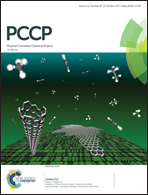Quercetin and its analogues: optical and acido–basic properties†
Abstract
This study is focused on eight structurally analogous natural flavonoids that exhibit a wide range of biological activities, which are of interest in pharmacy, cosmetics and the food industry. Using both experimental and theoretical approaches, we relate their fundamental physico-chemical properties to the structural motifs, with particular focus on UV/Vis absorption properties and pH dependence. We highlight the role of the C2–C3 double bond, whose presence or absence is responsible for the switch between absorption bands in the UVB and UVA regions, which is rationalized by strong modification of the involved molecular orbitals. After deprotonation in an alkaline environment, a typical switch in intensity at the maximum absorption wavelength (λmax) is observed enabling the calculation of pKa values for compounds with a C2–C3 single bond, whereas a bathochromic shift of λmaxvs. pH is observed for the C2–C3 double bond containing compounds. These behaviors are also rationalized and understood by MO analysis. Interestingly, high pH (above 11 for ampelopsin and above 9 for myricetin) induces the formation of a long-wavelength peak arising from double and/or triple deprotonation. Substitution at position C3 by the OH group has almost no effect on λmax for taxifolin and eriodictyol, whereas the effect is larger for quercetin and luteolin. An additional sugar moiety at C3 has a stabilizing effect and induces only minor changes in spectral behavior.



 Please wait while we load your content...
Please wait while we load your content...